A Study on the Influence of Islamic Architecture on Modern Buildings
VerifiedAdded on 2022/11/26
|17
|4534
|82
Essay
AI Summary
This essay investigates the significant influence of Islamic architecture on modern design, particularly focusing on the impact of courtyards and vaults. It begins by defining Islamic architecture and its origins, highlighting key features and design characteristics in both Indian and Persian contexts. The study details how Islamic architectural elements, such as courtyards, have influenced Western architecture, citing examples like the Marin Country Civic Center and the World Trade Center. The essay also discusses the evolution of Islamic architecture in contemporary times, including the rise of neo-Islamic styles and debates surrounding the integration of traditional and modern elements. Furthermore, it explores specific examples of Mughal architecture and its adoption by Western designers, emphasizing the enduring relevance of Islamic architectural principles like harmony, balance, and unity in modern building design. The essay concludes by underscoring the continued presence of Islamic architectural influences in modern buildings globally, demonstrating the lasting impact of Islamic design principles.
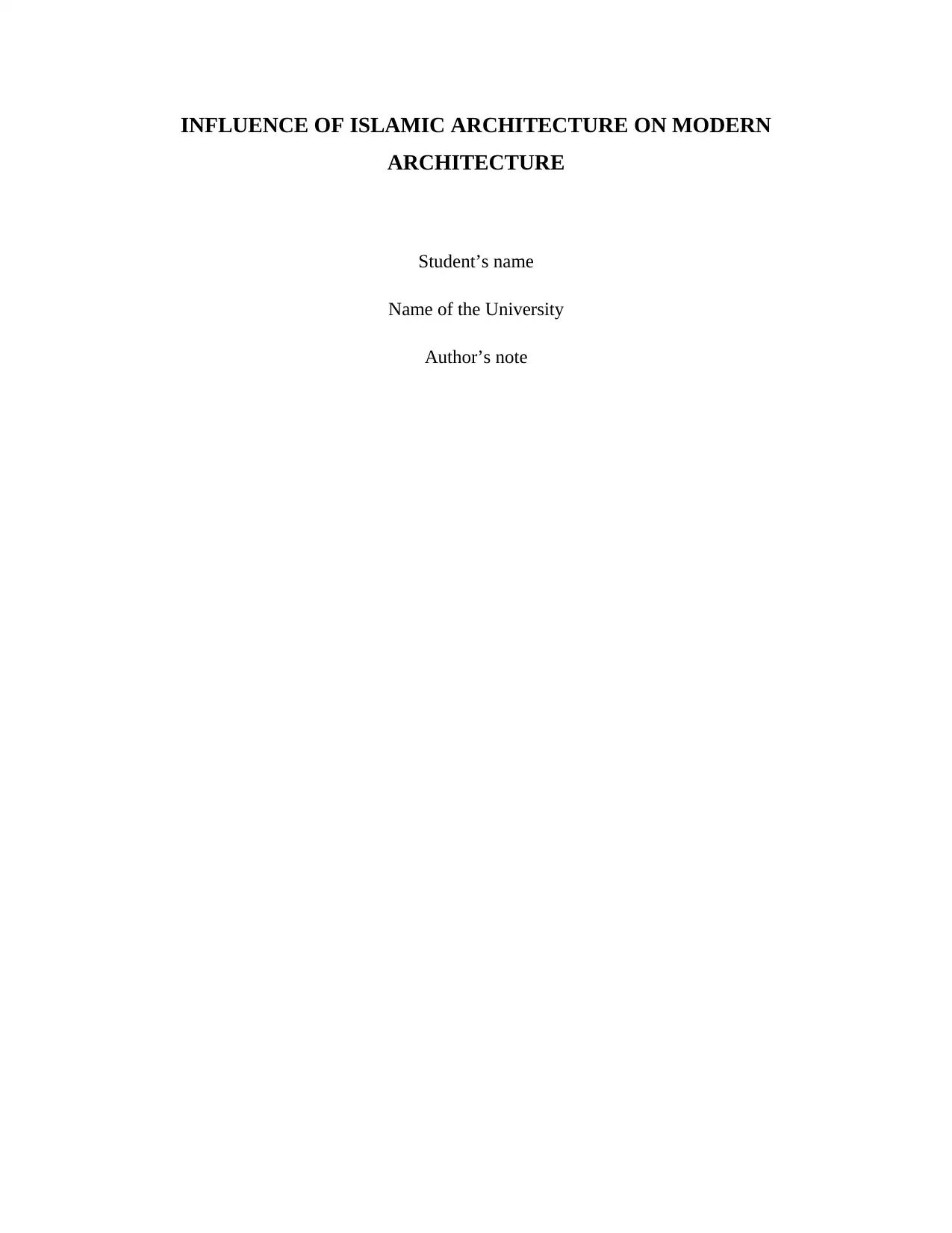
INFLUENCE OF ISLAMIC ARCHITECTURE ON MODERN
ARCHITECTURE
Student’s name
Name of the University
Author’s note
ARCHITECTURE
Student’s name
Name of the University
Author’s note
Paraphrase This Document
Need a fresh take? Get an instant paraphrase of this document with our AI Paraphraser
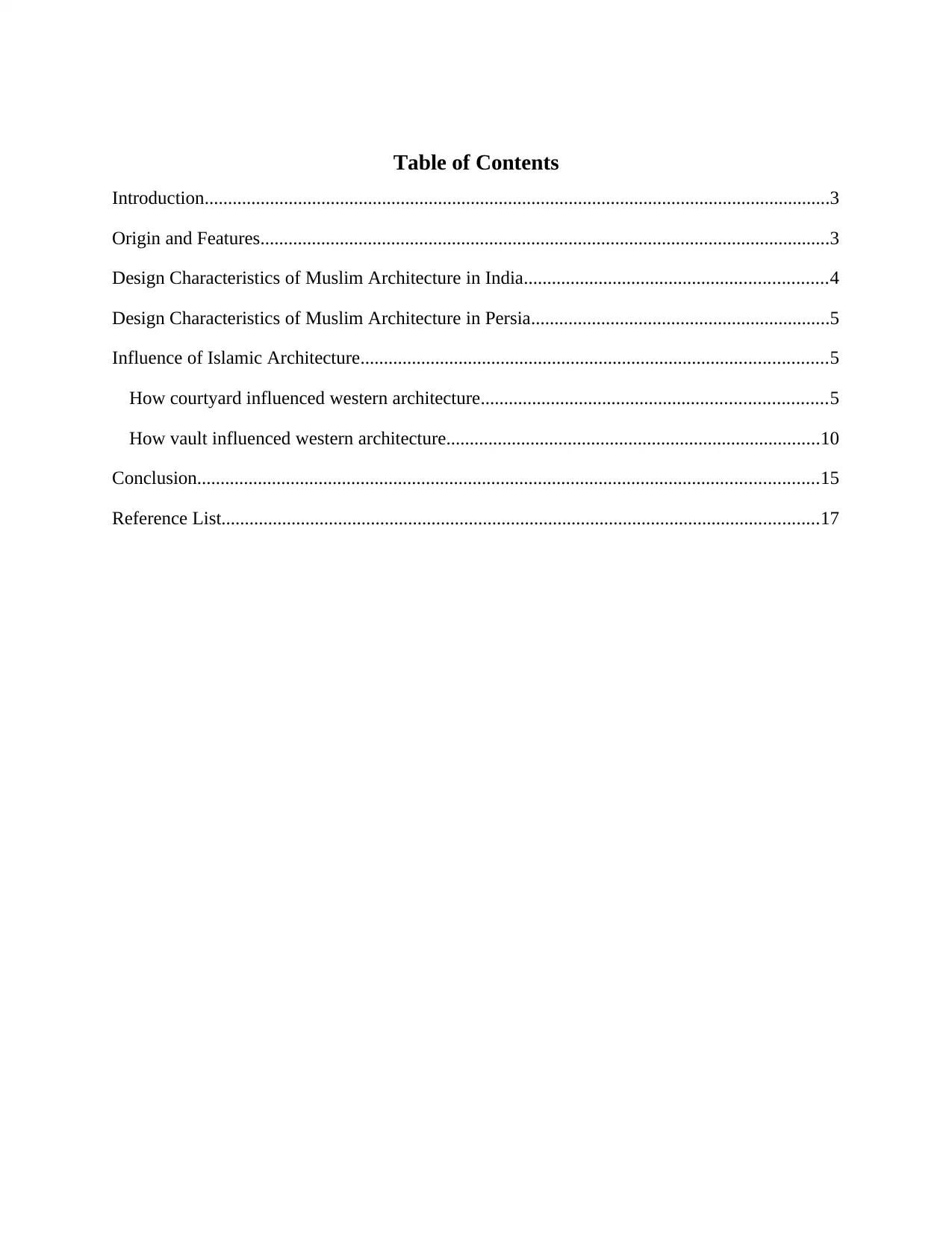
Table of Contents
Introduction......................................................................................................................................3
Origin and Features..........................................................................................................................3
Design Characteristics of Muslim Architecture in India.................................................................4
Design Characteristics of Muslim Architecture in Persia................................................................5
Influence of Islamic Architecture....................................................................................................5
How courtyard influenced western architecture..........................................................................5
How vault influenced western architecture................................................................................10
Conclusion.....................................................................................................................................15
Reference List................................................................................................................................17
Introduction......................................................................................................................................3
Origin and Features..........................................................................................................................3
Design Characteristics of Muslim Architecture in India.................................................................4
Design Characteristics of Muslim Architecture in Persia................................................................5
Influence of Islamic Architecture....................................................................................................5
How courtyard influenced western architecture..........................................................................5
How vault influenced western architecture................................................................................10
Conclusion.....................................................................................................................................15
Reference List................................................................................................................................17
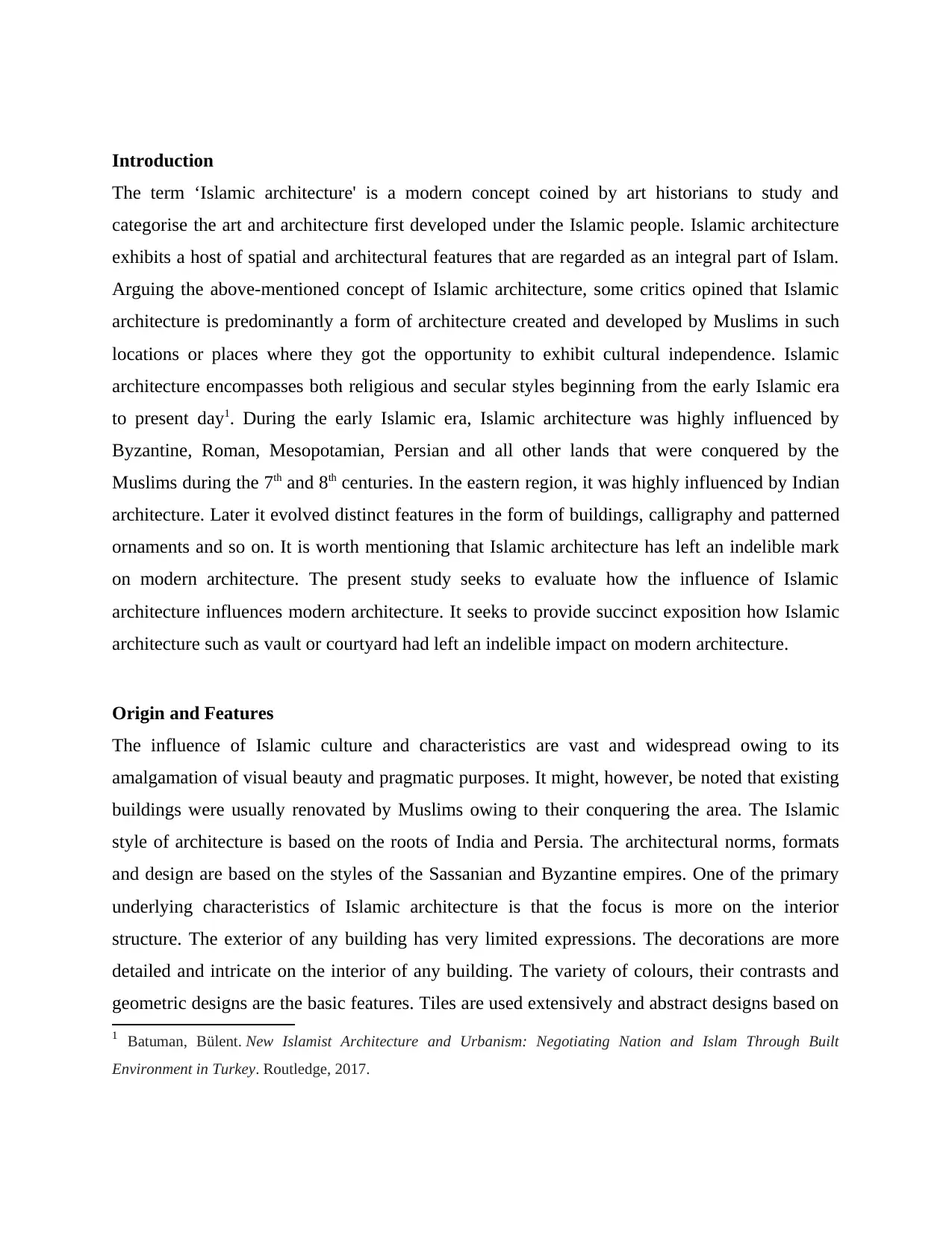
Introduction
The term ‘Islamic architecture' is a modern concept coined by art historians to study and
categorise the art and architecture first developed under the Islamic people. Islamic architecture
exhibits a host of spatial and architectural features that are regarded as an integral part of Islam.
Arguing the above-mentioned concept of Islamic architecture, some critics opined that Islamic
architecture is predominantly a form of architecture created and developed by Muslims in such
locations or places where they got the opportunity to exhibit cultural independence. Islamic
architecture encompasses both religious and secular styles beginning from the early Islamic era
to present day1. During the early Islamic era, Islamic architecture was highly influenced by
Byzantine, Roman, Mesopotamian, Persian and all other lands that were conquered by the
Muslims during the 7th and 8th centuries. In the eastern region, it was highly influenced by Indian
architecture. Later it evolved distinct features in the form of buildings, calligraphy and patterned
ornaments and so on. It is worth mentioning that Islamic architecture has left an indelible mark
on modern architecture. The present study seeks to evaluate how the influence of Islamic
architecture influences modern architecture. It seeks to provide succinct exposition how Islamic
architecture such as vault or courtyard had left an indelible impact on modern architecture.
Origin and Features
The influence of Islamic culture and characteristics are vast and widespread owing to its
amalgamation of visual beauty and pragmatic purposes. It might, however, be noted that existing
buildings were usually renovated by Muslims owing to their conquering the area. The Islamic
style of architecture is based on the roots of India and Persia. The architectural norms, formats
and design are based on the styles of the Sassanian and Byzantine empires. One of the primary
underlying characteristics of Islamic architecture is that the focus is more on the interior
structure. The exterior of any building has very limited expressions. The decorations are more
detailed and intricate on the interior of any building. The variety of colours, their contrasts and
geometric designs are the basic features. Tiles are used extensively and abstract designs based on
1 Batuman, Bülent. New Islamist Architecture and Urbanism: Negotiating Nation and Islam Through Built
Environment in Turkey. Routledge, 2017.
The term ‘Islamic architecture' is a modern concept coined by art historians to study and
categorise the art and architecture first developed under the Islamic people. Islamic architecture
exhibits a host of spatial and architectural features that are regarded as an integral part of Islam.
Arguing the above-mentioned concept of Islamic architecture, some critics opined that Islamic
architecture is predominantly a form of architecture created and developed by Muslims in such
locations or places where they got the opportunity to exhibit cultural independence. Islamic
architecture encompasses both religious and secular styles beginning from the early Islamic era
to present day1. During the early Islamic era, Islamic architecture was highly influenced by
Byzantine, Roman, Mesopotamian, Persian and all other lands that were conquered by the
Muslims during the 7th and 8th centuries. In the eastern region, it was highly influenced by Indian
architecture. Later it evolved distinct features in the form of buildings, calligraphy and patterned
ornaments and so on. It is worth mentioning that Islamic architecture has left an indelible mark
on modern architecture. The present study seeks to evaluate how the influence of Islamic
architecture influences modern architecture. It seeks to provide succinct exposition how Islamic
architecture such as vault or courtyard had left an indelible impact on modern architecture.
Origin and Features
The influence of Islamic culture and characteristics are vast and widespread owing to its
amalgamation of visual beauty and pragmatic purposes. It might, however, be noted that existing
buildings were usually renovated by Muslims owing to their conquering the area. The Islamic
style of architecture is based on the roots of India and Persia. The architectural norms, formats
and design are based on the styles of the Sassanian and Byzantine empires. One of the primary
underlying characteristics of Islamic architecture is that the focus is more on the interior
structure. The exterior of any building has very limited expressions. The decorations are more
detailed and intricate on the interior of any building. The variety of colours, their contrasts and
geometric designs are the basic features. Tiles are used extensively and abstract designs based on
1 Batuman, Bülent. New Islamist Architecture and Urbanism: Negotiating Nation and Islam Through Built
Environment in Turkey. Routledge, 2017.
⊘ This is a preview!⊘
Do you want full access?
Subscribe today to unlock all pages.

Trusted by 1+ million students worldwide
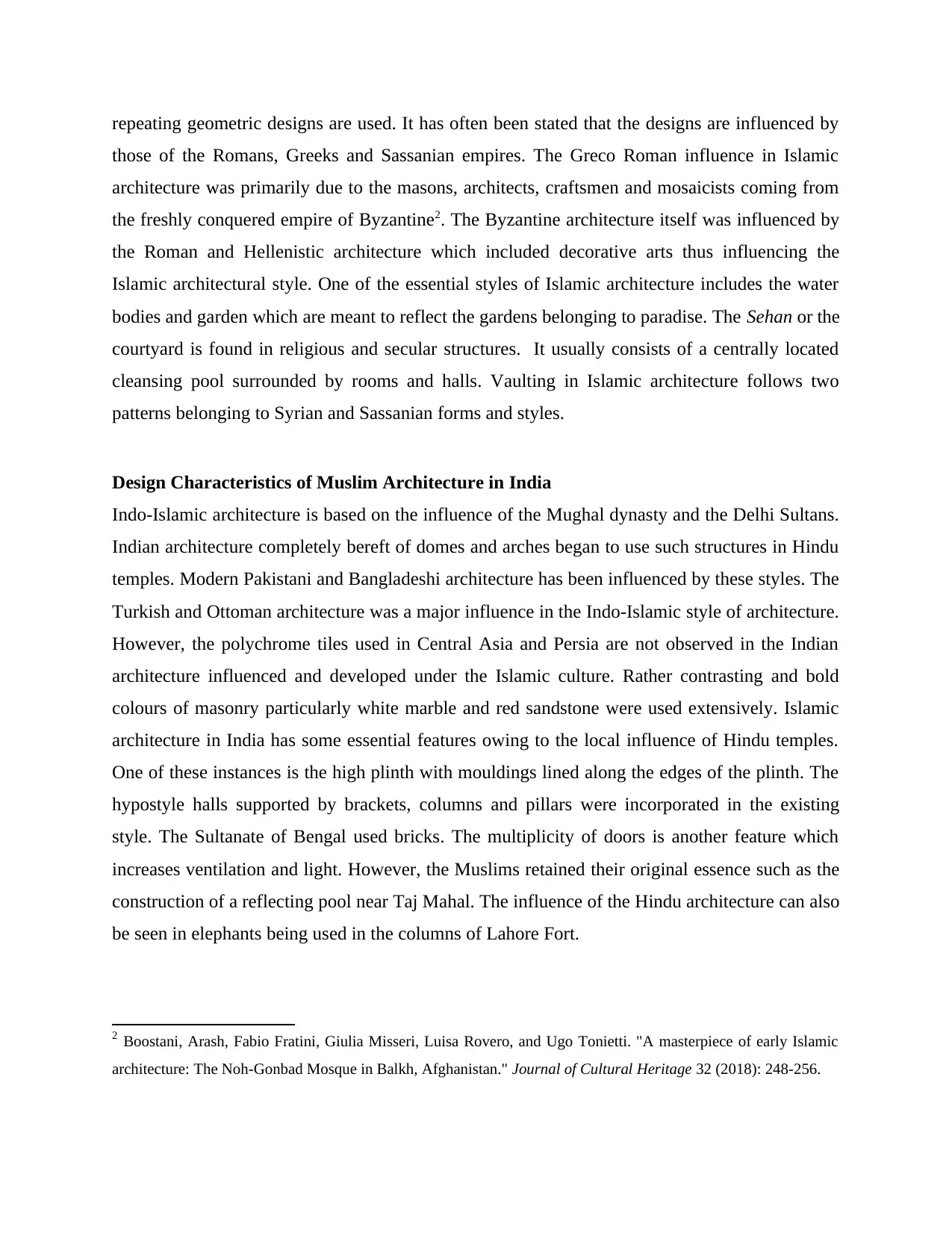
repeating geometric designs are used. It has often been stated that the designs are influenced by
those of the Romans, Greeks and Sassanian empires. The Greco Roman influence in Islamic
architecture was primarily due to the masons, architects, craftsmen and mosaicists coming from
the freshly conquered empire of Byzantine2. The Byzantine architecture itself was influenced by
the Roman and Hellenistic architecture which included decorative arts thus influencing the
Islamic architectural style. One of the essential styles of Islamic architecture includes the water
bodies and garden which are meant to reflect the gardens belonging to paradise. The Sehan or the
courtyard is found in religious and secular structures. It usually consists of a centrally located
cleansing pool surrounded by rooms and halls. Vaulting in Islamic architecture follows two
patterns belonging to Syrian and Sassanian forms and styles.
Design Characteristics of Muslim Architecture in India
Indo-Islamic architecture is based on the influence of the Mughal dynasty and the Delhi Sultans.
Indian architecture completely bereft of domes and arches began to use such structures in Hindu
temples. Modern Pakistani and Bangladeshi architecture has been influenced by these styles. The
Turkish and Ottoman architecture was a major influence in the Indo-Islamic style of architecture.
However, the polychrome tiles used in Central Asia and Persia are not observed in the Indian
architecture influenced and developed under the Islamic culture. Rather contrasting and bold
colours of masonry particularly white marble and red sandstone were used extensively. Islamic
architecture in India has some essential features owing to the local influence of Hindu temples.
One of these instances is the high plinth with mouldings lined along the edges of the plinth. The
hypostyle halls supported by brackets, columns and pillars were incorporated in the existing
style. The Sultanate of Bengal used bricks. The multiplicity of doors is another feature which
increases ventilation and light. However, the Muslims retained their original essence such as the
construction of a reflecting pool near Taj Mahal. The influence of the Hindu architecture can also
be seen in elephants being used in the columns of Lahore Fort.
2 Boostani, Arash, Fabio Fratini, Giulia Misseri, Luisa Rovero, and Ugo Tonietti. "A masterpiece of early Islamic
architecture: The Noh-Gonbad Mosque in Balkh, Afghanistan." Journal of Cultural Heritage 32 (2018): 248-256.
those of the Romans, Greeks and Sassanian empires. The Greco Roman influence in Islamic
architecture was primarily due to the masons, architects, craftsmen and mosaicists coming from
the freshly conquered empire of Byzantine2. The Byzantine architecture itself was influenced by
the Roman and Hellenistic architecture which included decorative arts thus influencing the
Islamic architectural style. One of the essential styles of Islamic architecture includes the water
bodies and garden which are meant to reflect the gardens belonging to paradise. The Sehan or the
courtyard is found in religious and secular structures. It usually consists of a centrally located
cleansing pool surrounded by rooms and halls. Vaulting in Islamic architecture follows two
patterns belonging to Syrian and Sassanian forms and styles.
Design Characteristics of Muslim Architecture in India
Indo-Islamic architecture is based on the influence of the Mughal dynasty and the Delhi Sultans.
Indian architecture completely bereft of domes and arches began to use such structures in Hindu
temples. Modern Pakistani and Bangladeshi architecture has been influenced by these styles. The
Turkish and Ottoman architecture was a major influence in the Indo-Islamic style of architecture.
However, the polychrome tiles used in Central Asia and Persia are not observed in the Indian
architecture influenced and developed under the Islamic culture. Rather contrasting and bold
colours of masonry particularly white marble and red sandstone were used extensively. Islamic
architecture in India has some essential features owing to the local influence of Hindu temples.
One of these instances is the high plinth with mouldings lined along the edges of the plinth. The
hypostyle halls supported by brackets, columns and pillars were incorporated in the existing
style. The Sultanate of Bengal used bricks. The multiplicity of doors is another feature which
increases ventilation and light. However, the Muslims retained their original essence such as the
construction of a reflecting pool near Taj Mahal. The influence of the Hindu architecture can also
be seen in elephants being used in the columns of Lahore Fort.
2 Boostani, Arash, Fabio Fratini, Giulia Misseri, Luisa Rovero, and Ugo Tonietti. "A masterpiece of early Islamic
architecture: The Noh-Gonbad Mosque in Balkh, Afghanistan." Journal of Cultural Heritage 32 (2018): 248-256.
Paraphrase This Document
Need a fresh take? Get an instant paraphrase of this document with our AI Paraphraser
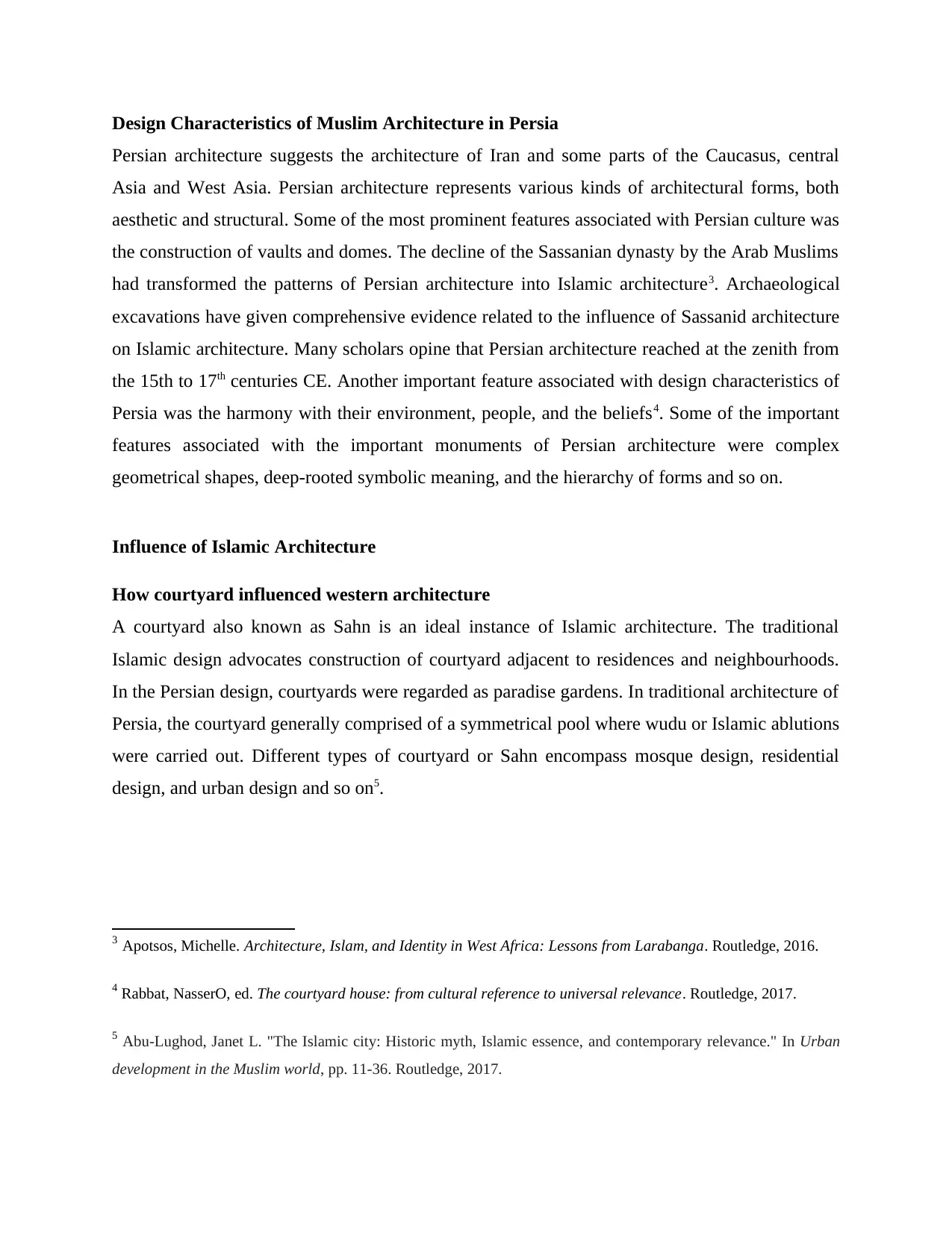
Design Characteristics of Muslim Architecture in Persia
Persian architecture suggests the architecture of Iran and some parts of the Caucasus, central
Asia and West Asia. Persian architecture represents various kinds of architectural forms, both
aesthetic and structural. Some of the most prominent features associated with Persian culture was
the construction of vaults and domes. The decline of the Sassanian dynasty by the Arab Muslims
had transformed the patterns of Persian architecture into Islamic architecture3. Archaeological
excavations have given comprehensive evidence related to the influence of Sassanid architecture
on Islamic architecture. Many scholars opine that Persian architecture reached at the zenith from
the 15th to 17th centuries CE. Another important feature associated with design characteristics of
Persia was the harmony with their environment, people, and the beliefs4. Some of the important
features associated with the important monuments of Persian architecture were complex
geometrical shapes, deep-rooted symbolic meaning, and the hierarchy of forms and so on.
Influence of Islamic Architecture
How courtyard influenced western architecture
A courtyard also known as Sahn is an ideal instance of Islamic architecture. The traditional
Islamic design advocates construction of courtyard adjacent to residences and neighbourhoods.
In the Persian design, courtyards were regarded as paradise gardens. In traditional architecture of
Persia, the courtyard generally comprised of a symmetrical pool where wudu or Islamic ablutions
were carried out. Different types of courtyard or Sahn encompass mosque design, residential
design, and urban design and so on5.
3 Apotsos, Michelle. Architecture, Islam, and Identity in West Africa: Lessons from Larabanga. Routledge, 2016.
4 Rabbat, NasserO, ed. The courtyard house: from cultural reference to universal relevance. Routledge, 2017.
5 Abu-Lughod, Janet L. "The Islamic city: Historic myth, Islamic essence, and contemporary relevance." In Urban
development in the Muslim world, pp. 11-36. Routledge, 2017.
Persian architecture suggests the architecture of Iran and some parts of the Caucasus, central
Asia and West Asia. Persian architecture represents various kinds of architectural forms, both
aesthetic and structural. Some of the most prominent features associated with Persian culture was
the construction of vaults and domes. The decline of the Sassanian dynasty by the Arab Muslims
had transformed the patterns of Persian architecture into Islamic architecture3. Archaeological
excavations have given comprehensive evidence related to the influence of Sassanid architecture
on Islamic architecture. Many scholars opine that Persian architecture reached at the zenith from
the 15th to 17th centuries CE. Another important feature associated with design characteristics of
Persia was the harmony with their environment, people, and the beliefs4. Some of the important
features associated with the important monuments of Persian architecture were complex
geometrical shapes, deep-rooted symbolic meaning, and the hierarchy of forms and so on.
Influence of Islamic Architecture
How courtyard influenced western architecture
A courtyard also known as Sahn is an ideal instance of Islamic architecture. The traditional
Islamic design advocates construction of courtyard adjacent to residences and neighbourhoods.
In the Persian design, courtyards were regarded as paradise gardens. In traditional architecture of
Persia, the courtyard generally comprised of a symmetrical pool where wudu or Islamic ablutions
were carried out. Different types of courtyard or Sahn encompass mosque design, residential
design, and urban design and so on5.
3 Apotsos, Michelle. Architecture, Islam, and Identity in West Africa: Lessons from Larabanga. Routledge, 2016.
4 Rabbat, NasserO, ed. The courtyard house: from cultural reference to universal relevance. Routledge, 2017.
5 Abu-Lughod, Janet L. "The Islamic city: Historic myth, Islamic essence, and contemporary relevance." In Urban
development in the Muslim world, pp. 11-36. Routledge, 2017.
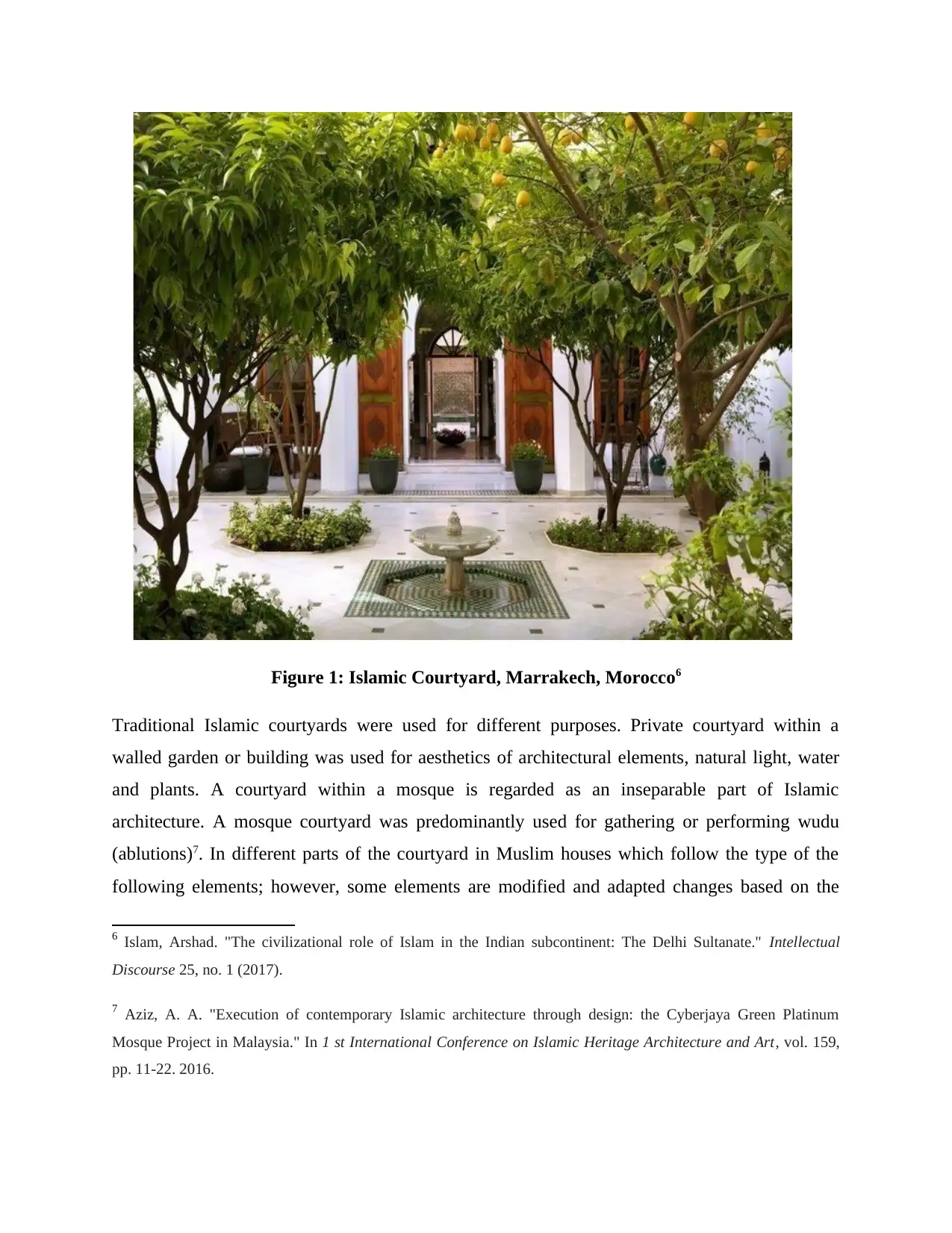
Figure 1: Islamic Courtyard, Marrakech, Morocco6
Traditional Islamic courtyards were used for different purposes. Private courtyard within a
walled garden or building was used for aesthetics of architectural elements, natural light, water
and plants. A courtyard within a mosque is regarded as an inseparable part of Islamic
architecture. A mosque courtyard was predominantly used for gathering or performing wudu
(ablutions)7. In different parts of the courtyard in Muslim houses which follow the type of the
following elements; however, some elements are modified and adapted changes based on the
6 Islam, Arshad. "The civilizational role of Islam in the Indian subcontinent: The Delhi Sultanate." Intellectual
Discourse 25, no. 1 (2017).
7 Aziz, A. A. "Execution of contemporary Islamic architecture through design: the Cyberjaya Green Platinum
Mosque Project in Malaysia." In 1 st International Conference on Islamic Heritage Architecture and Art, vol. 159,
pp. 11-22. 2016.
Traditional Islamic courtyards were used for different purposes. Private courtyard within a
walled garden or building was used for aesthetics of architectural elements, natural light, water
and plants. A courtyard within a mosque is regarded as an inseparable part of Islamic
architecture. A mosque courtyard was predominantly used for gathering or performing wudu
(ablutions)7. In different parts of the courtyard in Muslim houses which follow the type of the
following elements; however, some elements are modified and adapted changes based on the
6 Islam, Arshad. "The civilizational role of Islam in the Indian subcontinent: The Delhi Sultanate." Intellectual
Discourse 25, no. 1 (2017).
7 Aziz, A. A. "Execution of contemporary Islamic architecture through design: the Cyberjaya Green Platinum
Mosque Project in Malaysia." In 1 st International Conference on Islamic Heritage Architecture and Art, vol. 159,
pp. 11-22. 2016.
⊘ This is a preview!⊘
Do you want full access?
Subscribe today to unlock all pages.

Trusted by 1+ million students worldwide
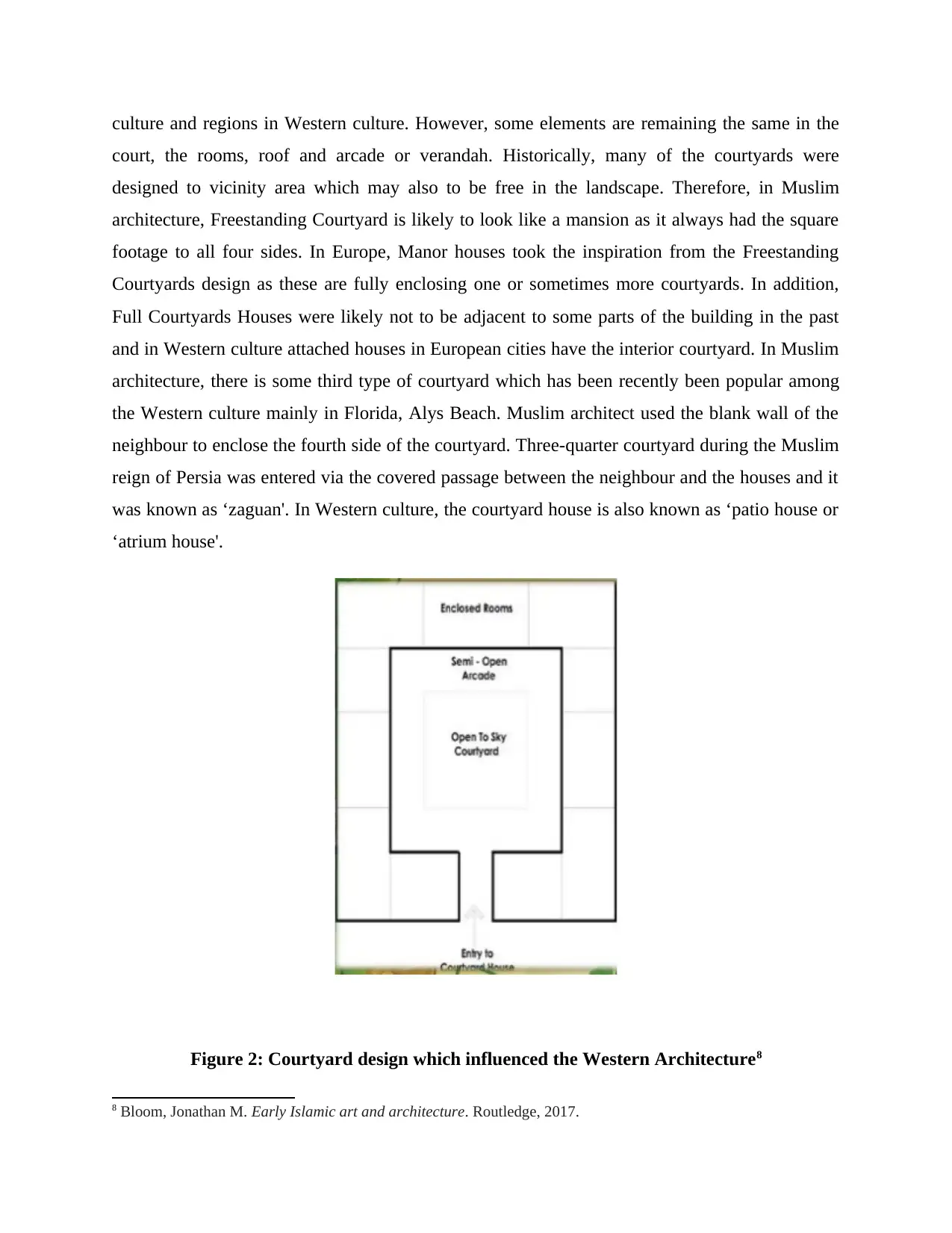
culture and regions in Western culture. However, some elements are remaining the same in the
court, the rooms, roof and arcade or verandah. Historically, many of the courtyards were
designed to vicinity area which may also to be free in the landscape. Therefore, in Muslim
architecture, Freestanding Courtyard is likely to look like a mansion as it always had the square
footage to all four sides. In Europe, Manor houses took the inspiration from the Freestanding
Courtyards design as these are fully enclosing one or sometimes more courtyards. In addition,
Full Courtyards Houses were likely not to be adjacent to some parts of the building in the past
and in Western culture attached houses in European cities have the interior courtyard. In Muslim
architecture, there is some third type of courtyard which has been recently been popular among
the Western culture mainly in Florida, Alys Beach. Muslim architect used the blank wall of the
neighbour to enclose the fourth side of the courtyard. Three-quarter courtyard during the Muslim
reign of Persia was entered via the covered passage between the neighbour and the houses and it
was known as ‘zaguan'. In Western culture, the courtyard house is also known as ‘patio house or
‘atrium house'.
Figure 2: Courtyard design which influenced the Western Architecture8
8 Bloom, Jonathan M. Early Islamic art and architecture. Routledge, 2017.
court, the rooms, roof and arcade or verandah. Historically, many of the courtyards were
designed to vicinity area which may also to be free in the landscape. Therefore, in Muslim
architecture, Freestanding Courtyard is likely to look like a mansion as it always had the square
footage to all four sides. In Europe, Manor houses took the inspiration from the Freestanding
Courtyards design as these are fully enclosing one or sometimes more courtyards. In addition,
Full Courtyards Houses were likely not to be adjacent to some parts of the building in the past
and in Western culture attached houses in European cities have the interior courtyard. In Muslim
architecture, there is some third type of courtyard which has been recently been popular among
the Western culture mainly in Florida, Alys Beach. Muslim architect used the blank wall of the
neighbour to enclose the fourth side of the courtyard. Three-quarter courtyard during the Muslim
reign of Persia was entered via the covered passage between the neighbour and the houses and it
was known as ‘zaguan'. In Western culture, the courtyard house is also known as ‘patio house or
‘atrium house'.
Figure 2: Courtyard design which influenced the Western Architecture8
8 Bloom, Jonathan M. Early Islamic art and architecture. Routledge, 2017.
Paraphrase This Document
Need a fresh take? Get an instant paraphrase of this document with our AI Paraphraser
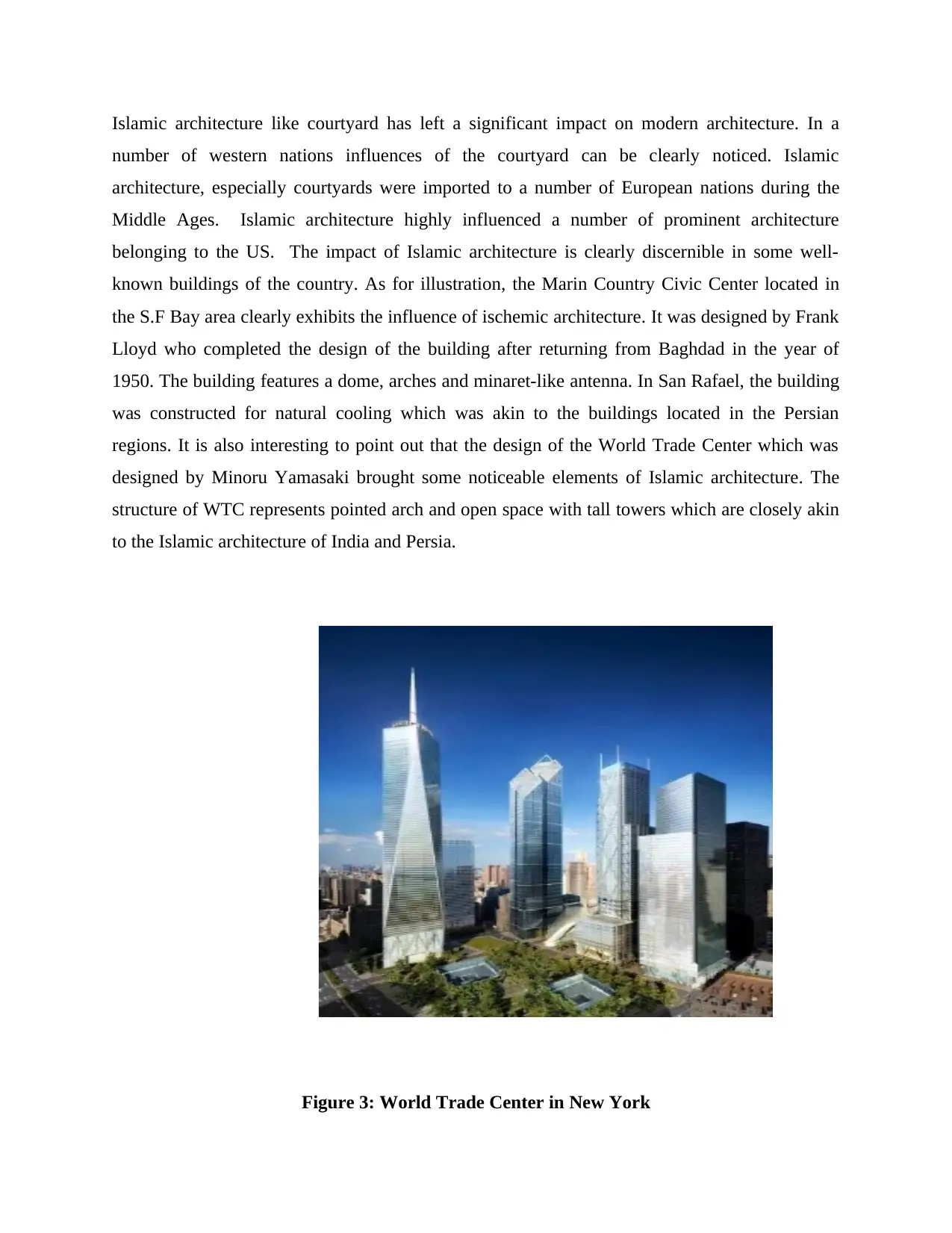
Islamic architecture like courtyard has left a significant impact on modern architecture. In a
number of western nations influences of the courtyard can be clearly noticed. Islamic
architecture, especially courtyards were imported to a number of European nations during the
Middle Ages. Islamic architecture highly influenced a number of prominent architecture
belonging to the US. The impact of Islamic architecture is clearly discernible in some well-
known buildings of the country. As for illustration, the Marin Country Civic Center located in
the S.F Bay area clearly exhibits the influence of ischemic architecture. It was designed by Frank
Lloyd who completed the design of the building after returning from Baghdad in the year of
1950. The building features a dome, arches and minaret-like antenna. In San Rafael, the building
was constructed for natural cooling which was akin to the buildings located in the Persian
regions. It is also interesting to point out that the design of the World Trade Center which was
designed by Minoru Yamasaki brought some noticeable elements of Islamic architecture. The
structure of WTC represents pointed arch and open space with tall towers which are closely akin
to the Islamic architecture of India and Persia.
Figure 3: World Trade Center in New York
number of western nations influences of the courtyard can be clearly noticed. Islamic
architecture, especially courtyards were imported to a number of European nations during the
Middle Ages. Islamic architecture highly influenced a number of prominent architecture
belonging to the US. The impact of Islamic architecture is clearly discernible in some well-
known buildings of the country. As for illustration, the Marin Country Civic Center located in
the S.F Bay area clearly exhibits the influence of ischemic architecture. It was designed by Frank
Lloyd who completed the design of the building after returning from Baghdad in the year of
1950. The building features a dome, arches and minaret-like antenna. In San Rafael, the building
was constructed for natural cooling which was akin to the buildings located in the Persian
regions. It is also interesting to point out that the design of the World Trade Center which was
designed by Minoru Yamasaki brought some noticeable elements of Islamic architecture. The
structure of WTC represents pointed arch and open space with tall towers which are closely akin
to the Islamic architecture of India and Persia.
Figure 3: World Trade Center in New York
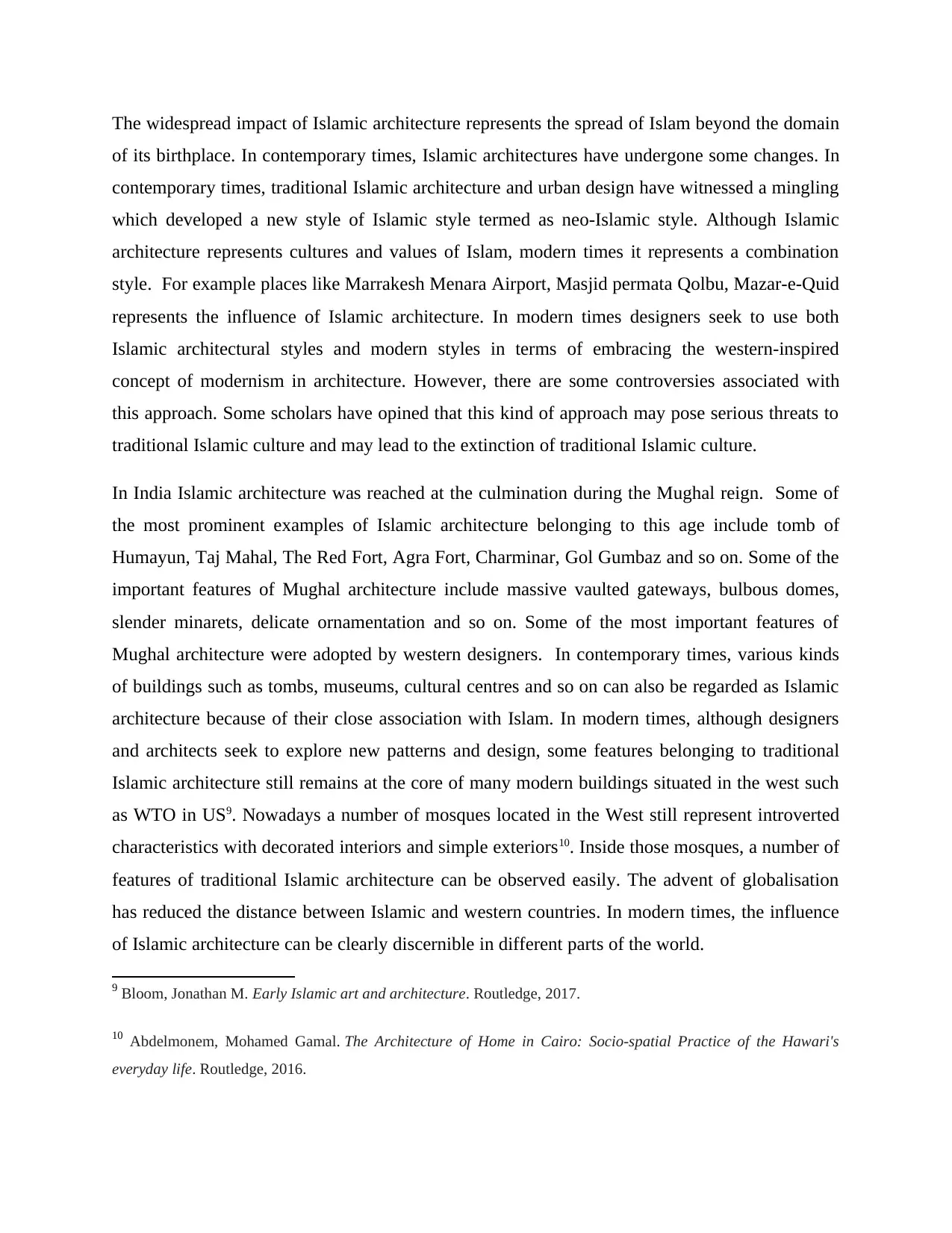
The widespread impact of Islamic architecture represents the spread of Islam beyond the domain
of its birthplace. In contemporary times, Islamic architectures have undergone some changes. In
contemporary times, traditional Islamic architecture and urban design have witnessed a mingling
which developed a new style of Islamic style termed as neo-Islamic style. Although Islamic
architecture represents cultures and values of Islam, modern times it represents a combination
style. For example places like Marrakesh Menara Airport, Masjid permata Qolbu, Mazar-e-Quid
represents the influence of Islamic architecture. In modern times designers seek to use both
Islamic architectural styles and modern styles in terms of embracing the western-inspired
concept of modernism in architecture. However, there are some controversies associated with
this approach. Some scholars have opined that this kind of approach may pose serious threats to
traditional Islamic culture and may lead to the extinction of traditional Islamic culture.
In India Islamic architecture was reached at the culmination during the Mughal reign. Some of
the most prominent examples of Islamic architecture belonging to this age include tomb of
Humayun, Taj Mahal, The Red Fort, Agra Fort, Charminar, Gol Gumbaz and so on. Some of the
important features of Mughal architecture include massive vaulted gateways, bulbous domes,
slender minarets, delicate ornamentation and so on. Some of the most important features of
Mughal architecture were adopted by western designers. In contemporary times, various kinds
of buildings such as tombs, museums, cultural centres and so on can also be regarded as Islamic
architecture because of their close association with Islam. In modern times, although designers
and architects seek to explore new patterns and design, some features belonging to traditional
Islamic architecture still remains at the core of many modern buildings situated in the west such
as WTO in US9. Nowadays a number of mosques located in the West still represent introverted
characteristics with decorated interiors and simple exteriors10. Inside those mosques, a number of
features of traditional Islamic architecture can be observed easily. The advent of globalisation
has reduced the distance between Islamic and western countries. In modern times, the influence
of Islamic architecture can be clearly discernible in different parts of the world.
9 Bloom, Jonathan M. Early Islamic art and architecture. Routledge, 2017.
10 Abdelmonem, Mohamed Gamal. The Architecture of Home in Cairo: Socio-spatial Practice of the Hawari's
everyday life. Routledge, 2016.
of its birthplace. In contemporary times, Islamic architectures have undergone some changes. In
contemporary times, traditional Islamic architecture and urban design have witnessed a mingling
which developed a new style of Islamic style termed as neo-Islamic style. Although Islamic
architecture represents cultures and values of Islam, modern times it represents a combination
style. For example places like Marrakesh Menara Airport, Masjid permata Qolbu, Mazar-e-Quid
represents the influence of Islamic architecture. In modern times designers seek to use both
Islamic architectural styles and modern styles in terms of embracing the western-inspired
concept of modernism in architecture. However, there are some controversies associated with
this approach. Some scholars have opined that this kind of approach may pose serious threats to
traditional Islamic culture and may lead to the extinction of traditional Islamic culture.
In India Islamic architecture was reached at the culmination during the Mughal reign. Some of
the most prominent examples of Islamic architecture belonging to this age include tomb of
Humayun, Taj Mahal, The Red Fort, Agra Fort, Charminar, Gol Gumbaz and so on. Some of the
important features of Mughal architecture include massive vaulted gateways, bulbous domes,
slender minarets, delicate ornamentation and so on. Some of the most important features of
Mughal architecture were adopted by western designers. In contemporary times, various kinds
of buildings such as tombs, museums, cultural centres and so on can also be regarded as Islamic
architecture because of their close association with Islam. In modern times, although designers
and architects seek to explore new patterns and design, some features belonging to traditional
Islamic architecture still remains at the core of many modern buildings situated in the west such
as WTO in US9. Nowadays a number of mosques located in the West still represent introverted
characteristics with decorated interiors and simple exteriors10. Inside those mosques, a number of
features of traditional Islamic architecture can be observed easily. The advent of globalisation
has reduced the distance between Islamic and western countries. In modern times, the influence
of Islamic architecture can be clearly discernible in different parts of the world.
9 Bloom, Jonathan M. Early Islamic art and architecture. Routledge, 2017.
10 Abdelmonem, Mohamed Gamal. The Architecture of Home in Cairo: Socio-spatial Practice of the Hawari's
everyday life. Routledge, 2016.
⊘ This is a preview!⊘
Do you want full access?
Subscribe today to unlock all pages.

Trusted by 1+ million students worldwide
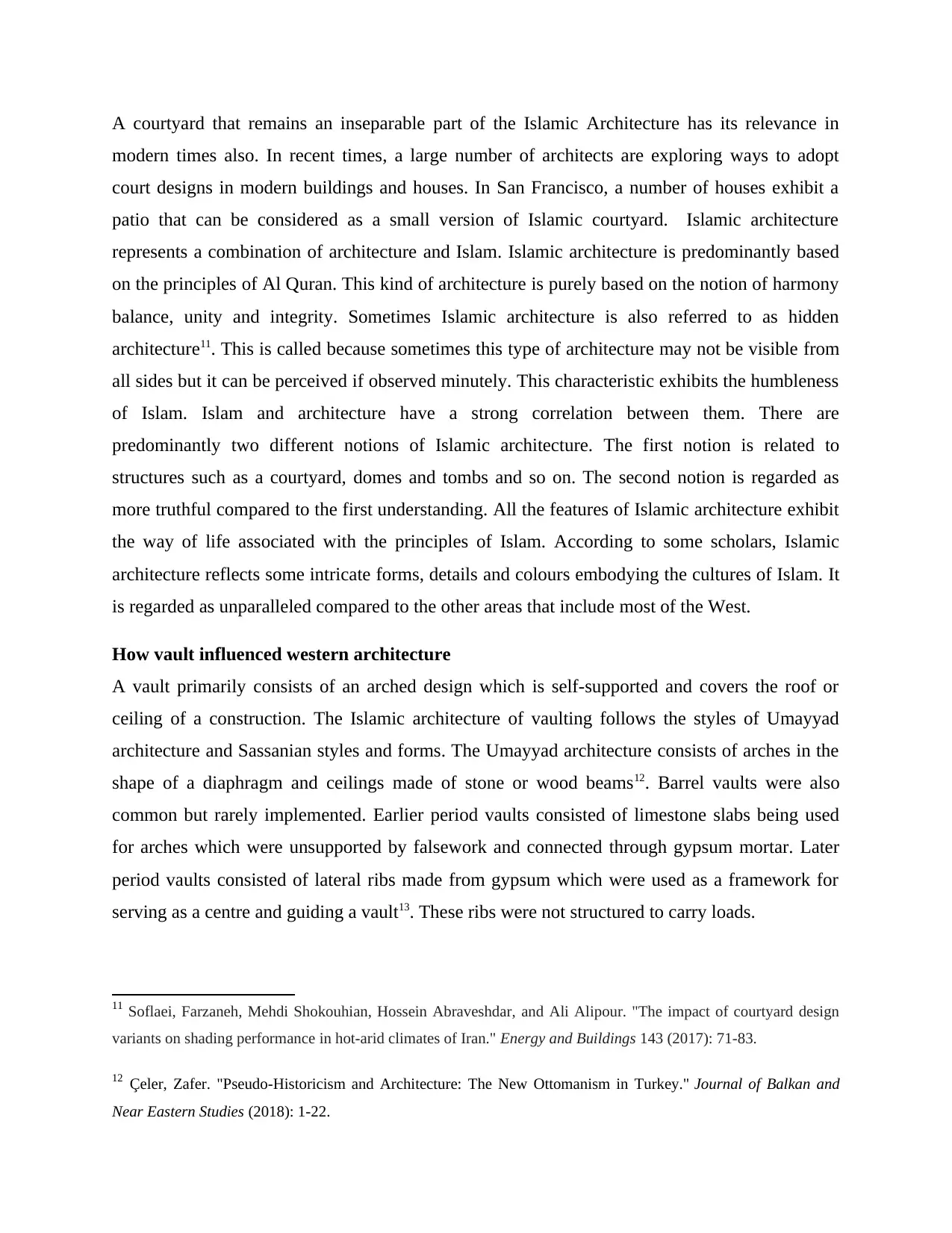
A courtyard that remains an inseparable part of the Islamic Architecture has its relevance in
modern times also. In recent times, a large number of architects are exploring ways to adopt
court designs in modern buildings and houses. In San Francisco, a number of houses exhibit a
patio that can be considered as a small version of Islamic courtyard. Islamic architecture
represents a combination of architecture and Islam. Islamic architecture is predominantly based
on the principles of Al Quran. This kind of architecture is purely based on the notion of harmony
balance, unity and integrity. Sometimes Islamic architecture is also referred to as hidden
architecture11. This is called because sometimes this type of architecture may not be visible from
all sides but it can be perceived if observed minutely. This characteristic exhibits the humbleness
of Islam. Islam and architecture have a strong correlation between them. There are
predominantly two different notions of Islamic architecture. The first notion is related to
structures such as a courtyard, domes and tombs and so on. The second notion is regarded as
more truthful compared to the first understanding. All the features of Islamic architecture exhibit
the way of life associated with the principles of Islam. According to some scholars, Islamic
architecture reflects some intricate forms, details and colours embodying the cultures of Islam. It
is regarded as unparalleled compared to the other areas that include most of the West.
How vault influenced western architecture
A vault primarily consists of an arched design which is self-supported and covers the roof or
ceiling of a construction. The Islamic architecture of vaulting follows the styles of Umayyad
architecture and Sassanian styles and forms. The Umayyad architecture consists of arches in the
shape of a diaphragm and ceilings made of stone or wood beams12. Barrel vaults were also
common but rarely implemented. Earlier period vaults consisted of limestone slabs being used
for arches which were unsupported by falsework and connected through gypsum mortar. Later
period vaults consisted of lateral ribs made from gypsum which were used as a framework for
serving as a centre and guiding a vault13. These ribs were not structured to carry loads.
11 Soflaei, Farzaneh, Mehdi Shokouhian, Hossein Abraveshdar, and Ali Alipour. "The impact of courtyard design
variants on shading performance in hot-arid climates of Iran." Energy and Buildings 143 (2017): 71-83.
12 Çeler, Zafer. "Pseudo-Historicism and Architecture: The New Ottomanism in Turkey." Journal of Balkan and
Near Eastern Studies (2018): 1-22.
modern times also. In recent times, a large number of architects are exploring ways to adopt
court designs in modern buildings and houses. In San Francisco, a number of houses exhibit a
patio that can be considered as a small version of Islamic courtyard. Islamic architecture
represents a combination of architecture and Islam. Islamic architecture is predominantly based
on the principles of Al Quran. This kind of architecture is purely based on the notion of harmony
balance, unity and integrity. Sometimes Islamic architecture is also referred to as hidden
architecture11. This is called because sometimes this type of architecture may not be visible from
all sides but it can be perceived if observed minutely. This characteristic exhibits the humbleness
of Islam. Islam and architecture have a strong correlation between them. There are
predominantly two different notions of Islamic architecture. The first notion is related to
structures such as a courtyard, domes and tombs and so on. The second notion is regarded as
more truthful compared to the first understanding. All the features of Islamic architecture exhibit
the way of life associated with the principles of Islam. According to some scholars, Islamic
architecture reflects some intricate forms, details and colours embodying the cultures of Islam. It
is regarded as unparalleled compared to the other areas that include most of the West.
How vault influenced western architecture
A vault primarily consists of an arched design which is self-supported and covers the roof or
ceiling of a construction. The Islamic architecture of vaulting follows the styles of Umayyad
architecture and Sassanian styles and forms. The Umayyad architecture consists of arches in the
shape of a diaphragm and ceilings made of stone or wood beams12. Barrel vaults were also
common but rarely implemented. Earlier period vaults consisted of limestone slabs being used
for arches which were unsupported by falsework and connected through gypsum mortar. Later
period vaults consisted of lateral ribs made from gypsum which were used as a framework for
serving as a centre and guiding a vault13. These ribs were not structured to carry loads.
11 Soflaei, Farzaneh, Mehdi Shokouhian, Hossein Abraveshdar, and Ali Alipour. "The impact of courtyard design
variants on shading performance in hot-arid climates of Iran." Energy and Buildings 143 (2017): 71-83.
12 Çeler, Zafer. "Pseudo-Historicism and Architecture: The New Ottomanism in Turkey." Journal of Balkan and
Near Eastern Studies (2018): 1-22.
Paraphrase This Document
Need a fresh take? Get an instant paraphrase of this document with our AI Paraphraser
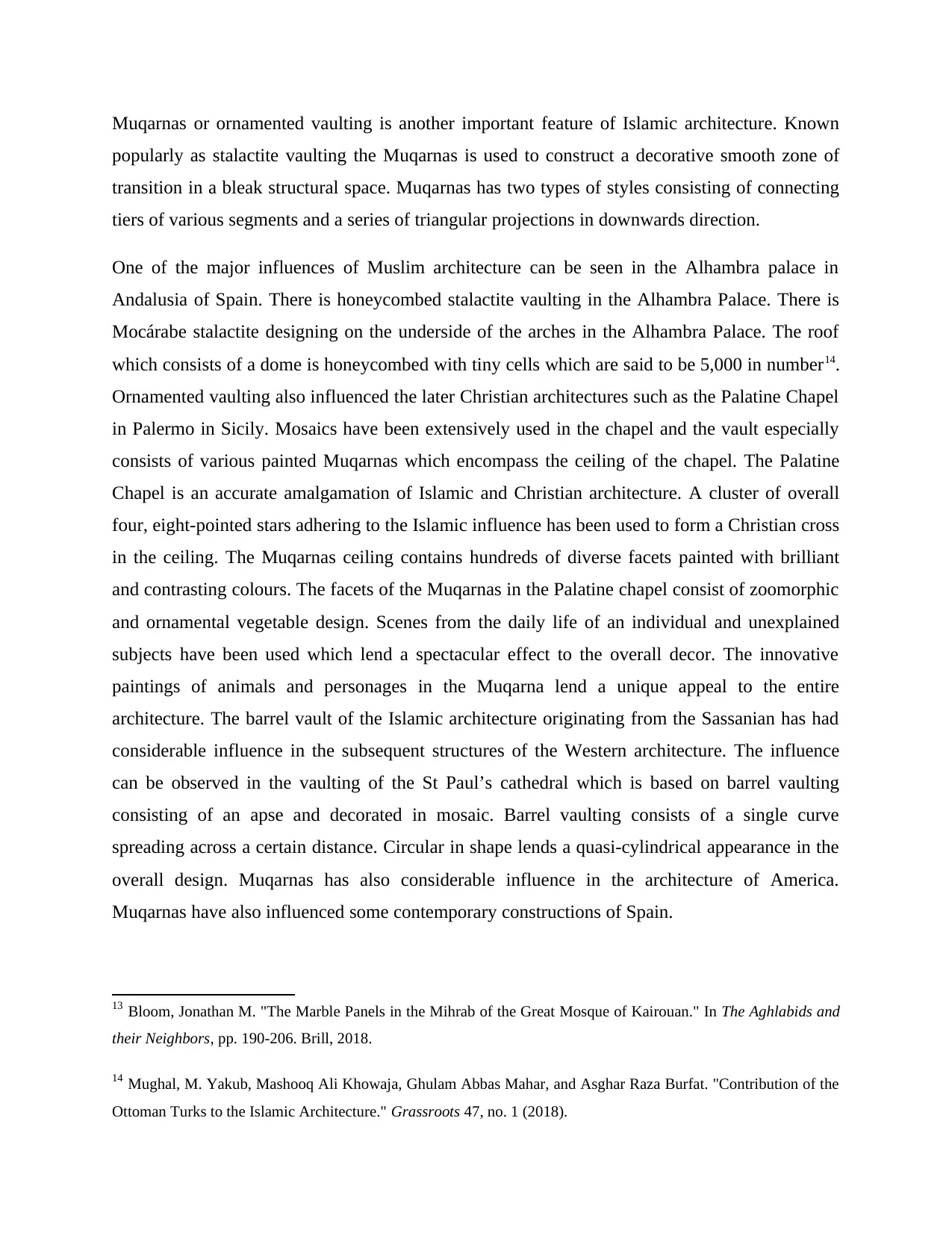
Muqarnas or ornamented vaulting is another important feature of Islamic architecture. Known
popularly as stalactite vaulting the Muqarnas is used to construct a decorative smooth zone of
transition in a bleak structural space. Muqarnas has two types of styles consisting of connecting
tiers of various segments and a series of triangular projections in downwards direction.
One of the major influences of Muslim architecture can be seen in the Alhambra palace in
Andalusia of Spain. There is honeycombed stalactite vaulting in the Alhambra Palace. There is
Mocárabe stalactite designing on the underside of the arches in the Alhambra Palace. The roof
which consists of a dome is honeycombed with tiny cells which are said to be 5,000 in number14.
Ornamented vaulting also influenced the later Christian architectures such as the Palatine Chapel
in Palermo in Sicily. Mosaics have been extensively used in the chapel and the vault especially
consists of various painted Muqarnas which encompass the ceiling of the chapel. The Palatine
Chapel is an accurate amalgamation of Islamic and Christian architecture. A cluster of overall
four, eight-pointed stars adhering to the Islamic influence has been used to form a Christian cross
in the ceiling. The Muqarnas ceiling contains hundreds of diverse facets painted with brilliant
and contrasting colours. The facets of the Muqarnas in the Palatine chapel consist of zoomorphic
and ornamental vegetable design. Scenes from the daily life of an individual and unexplained
subjects have been used which lend a spectacular effect to the overall decor. The innovative
paintings of animals and personages in the Muqarna lend a unique appeal to the entire
architecture. The barrel vault of the Islamic architecture originating from the Sassanian has had
considerable influence in the subsequent structures of the Western architecture. The influence
can be observed in the vaulting of the St Paul’s cathedral which is based on barrel vaulting
consisting of an apse and decorated in mosaic. Barrel vaulting consists of a single curve
spreading across a certain distance. Circular in shape lends a quasi-cylindrical appearance in the
overall design. Muqarnas has also considerable influence in the architecture of America.
Muqarnas have also influenced some contemporary constructions of Spain.
13 Bloom, Jonathan M. "The Marble Panels in the Mihrab of the Great Mosque of Kairouan." In The Aghlabids and
their Neighbors, pp. 190-206. Brill, 2018.
14 Mughal, M. Yakub, Mashooq Ali Khowaja, Ghulam Abbas Mahar, and Asghar Raza Burfat. "Contribution of the
Ottoman Turks to the Islamic Architecture." Grassroots 47, no. 1 (2018).
popularly as stalactite vaulting the Muqarnas is used to construct a decorative smooth zone of
transition in a bleak structural space. Muqarnas has two types of styles consisting of connecting
tiers of various segments and a series of triangular projections in downwards direction.
One of the major influences of Muslim architecture can be seen in the Alhambra palace in
Andalusia of Spain. There is honeycombed stalactite vaulting in the Alhambra Palace. There is
Mocárabe stalactite designing on the underside of the arches in the Alhambra Palace. The roof
which consists of a dome is honeycombed with tiny cells which are said to be 5,000 in number14.
Ornamented vaulting also influenced the later Christian architectures such as the Palatine Chapel
in Palermo in Sicily. Mosaics have been extensively used in the chapel and the vault especially
consists of various painted Muqarnas which encompass the ceiling of the chapel. The Palatine
Chapel is an accurate amalgamation of Islamic and Christian architecture. A cluster of overall
four, eight-pointed stars adhering to the Islamic influence has been used to form a Christian cross
in the ceiling. The Muqarnas ceiling contains hundreds of diverse facets painted with brilliant
and contrasting colours. The facets of the Muqarnas in the Palatine chapel consist of zoomorphic
and ornamental vegetable design. Scenes from the daily life of an individual and unexplained
subjects have been used which lend a spectacular effect to the overall decor. The innovative
paintings of animals and personages in the Muqarna lend a unique appeal to the entire
architecture. The barrel vault of the Islamic architecture originating from the Sassanian has had
considerable influence in the subsequent structures of the Western architecture. The influence
can be observed in the vaulting of the St Paul’s cathedral which is based on barrel vaulting
consisting of an apse and decorated in mosaic. Barrel vaulting consists of a single curve
spreading across a certain distance. Circular in shape lends a quasi-cylindrical appearance in the
overall design. Muqarnas has also considerable influence in the architecture of America.
Muqarnas have also influenced some contemporary constructions of Spain.
13 Bloom, Jonathan M. "The Marble Panels in the Mihrab of the Great Mosque of Kairouan." In The Aghlabids and
their Neighbors, pp. 190-206. Brill, 2018.
14 Mughal, M. Yakub, Mashooq Ali Khowaja, Ghulam Abbas Mahar, and Asghar Raza Burfat. "Contribution of the
Ottoman Turks to the Islamic Architecture." Grassroots 47, no. 1 (2018).
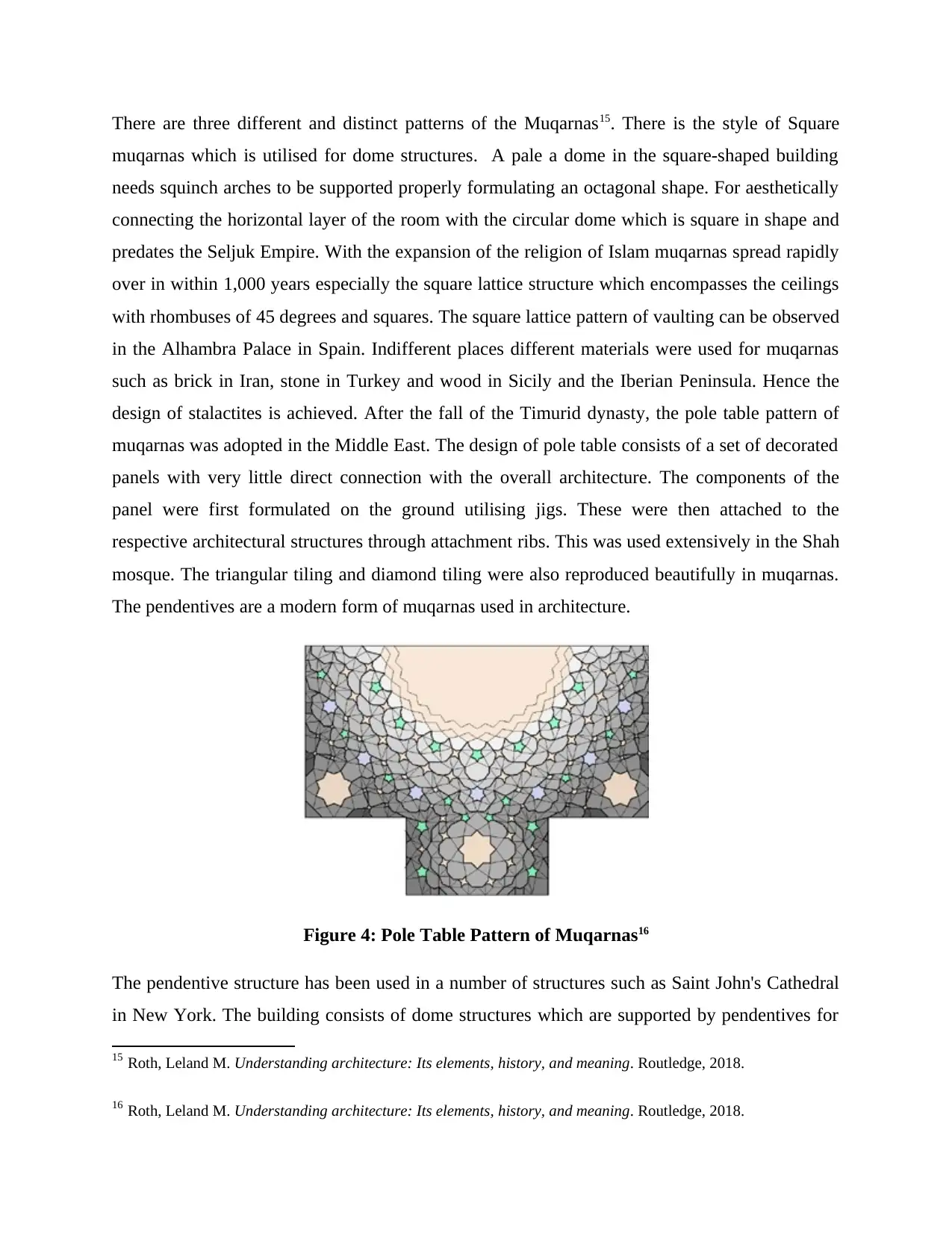
There are three different and distinct patterns of the Muqarnas15. There is the style of Square
muqarnas which is utilised for dome structures. A pale a dome in the square-shaped building
needs squinch arches to be supported properly formulating an octagonal shape. For aesthetically
connecting the horizontal layer of the room with the circular dome which is square in shape and
predates the Seljuk Empire. With the expansion of the religion of Islam muqarnas spread rapidly
over in within 1,000 years especially the square lattice structure which encompasses the ceilings
with rhombuses of 45 degrees and squares. The square lattice pattern of vaulting can be observed
in the Alhambra Palace in Spain. Indifferent places different materials were used for muqarnas
such as brick in Iran, stone in Turkey and wood in Sicily and the Iberian Peninsula. Hence the
design of stalactites is achieved. After the fall of the Timurid dynasty, the pole table pattern of
muqarnas was adopted in the Middle East. The design of pole table consists of a set of decorated
panels with very little direct connection with the overall architecture. The components of the
panel were first formulated on the ground utilising jigs. These were then attached to the
respective architectural structures through attachment ribs. This was used extensively in the Shah
mosque. The triangular tiling and diamond tiling were also reproduced beautifully in muqarnas.
The pendentives are a modern form of muqarnas used in architecture.
Figure 4: Pole Table Pattern of Muqarnas16
The pendentive structure has been used in a number of structures such as Saint John's Cathedral
in New York. The building consists of dome structures which are supported by pendentives for
15 Roth, Leland M. Understanding architecture: Its elements, history, and meaning. Routledge, 2018.
16 Roth, Leland M. Understanding architecture: Its elements, history, and meaning. Routledge, 2018.
muqarnas which is utilised for dome structures. A pale a dome in the square-shaped building
needs squinch arches to be supported properly formulating an octagonal shape. For aesthetically
connecting the horizontal layer of the room with the circular dome which is square in shape and
predates the Seljuk Empire. With the expansion of the religion of Islam muqarnas spread rapidly
over in within 1,000 years especially the square lattice structure which encompasses the ceilings
with rhombuses of 45 degrees and squares. The square lattice pattern of vaulting can be observed
in the Alhambra Palace in Spain. Indifferent places different materials were used for muqarnas
such as brick in Iran, stone in Turkey and wood in Sicily and the Iberian Peninsula. Hence the
design of stalactites is achieved. After the fall of the Timurid dynasty, the pole table pattern of
muqarnas was adopted in the Middle East. The design of pole table consists of a set of decorated
panels with very little direct connection with the overall architecture. The components of the
panel were first formulated on the ground utilising jigs. These were then attached to the
respective architectural structures through attachment ribs. This was used extensively in the Shah
mosque. The triangular tiling and diamond tiling were also reproduced beautifully in muqarnas.
The pendentives are a modern form of muqarnas used in architecture.
Figure 4: Pole Table Pattern of Muqarnas16
The pendentive structure has been used in a number of structures such as Saint John's Cathedral
in New York. The building consists of dome structures which are supported by pendentives for
15 Roth, Leland M. Understanding architecture: Its elements, history, and meaning. Routledge, 2018.
16 Roth, Leland M. Understanding architecture: Its elements, history, and meaning. Routledge, 2018.
⊘ This is a preview!⊘
Do you want full access?
Subscribe today to unlock all pages.

Trusted by 1+ million students worldwide
1 out of 17
Your All-in-One AI-Powered Toolkit for Academic Success.
+13062052269
info@desklib.com
Available 24*7 on WhatsApp / Email
![[object Object]](/_next/static/media/star-bottom.7253800d.svg)
Unlock your academic potential
Copyright © 2020–2025 A2Z Services. All Rights Reserved. Developed and managed by ZUCOL.

